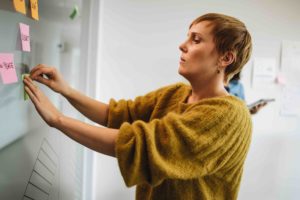If you’re an expert in your field, you probably know all too well the infamous "curse of knowledge".
This expression, coined in 1989 by economists Colin Camerer, George Loewenstein, and Martin Weber, refers to a cognitive bias that makes it hard for us to imagine what it was like not to know something, once we’ve already learned it.
The Expert’s Abstraction versus The Beginner’s Concrete World
In teaching, this gap shows up fast: the more we master a subject, the more abstract it becomes to us — while learners need clarity, tangibility, and step-by-step guidance to make sense of it all.
This often results in overly complex explanations, where we unintentionally skip the “simple” parts — the ones beginners truly rely on. precisam aprender – justamente por nos parecerem bobagem – e cria uma enorme distância entre facilitador e aprendiz.
But if we don’t meet our students where they are, we’ll never be able to guide them to where they need to go.
Meet learners where they are
In those first steps, it’s normal to fear you’re oversimplifying — but it’s important to remember that learning is a a gradual, layered journey.. Every complex idea stands on simple foundations — no one skips 2 + 2 on the way to mastering big things.
Still, it’s important to avoid the other extreme: beginning at a level that underestimates what your group already knows. The Flow, a concept defined by psychologist Mihaly Csikszentmihalyi, where we’re fully engaged and driven to continue — is key to effective learning. It depends on striking the right balance between existing skills and the level of challenge.
High challenge with low skill creates anxiety; high skill with low challenge creates boredom — neither supports real learning.
No Crystal Ball Needed: How to Figure Out What Your Students Actually Know
The truth is, meeting learners where they are doesn’t require remembering everything — and that’s a relief.
People bring different stories, experiences, and starting points — especially in adult learning. And that diversity is a strength.
That’s why we start with what the learners themselves already know (or think they know) — and build from there.
This kind of insight can come from pre-course exploration — and just as powerfully, from what happens inside the classroom. Ideally, it’s a combination.
Taking the reverse path, in fact, is a great way to engage students with the content. Instead of explaining ⇒ demonstrating ⇒ giving them an exercise,by using an experiential learning model, like Kolb’s, we invite students to learn by doing, reflecting, and connecting.
Despite the content-heavy methods many of us were exposed to, teaching is much more about pulling the student in — inviting them to walk a learning path — than pushing concepts for them to simply memorize.
Considerar outras experiências e vivências paralelas que o aprendiz tenha, vai ajudar a transpor conceitos mais complexos, facilitando o ensino, sem que você precise abraçar o simplismo – e ainda tornar as aulas muito mais interessantes.
Looking to create experiences that turn content into true learning? Discover how we can support your journey!





